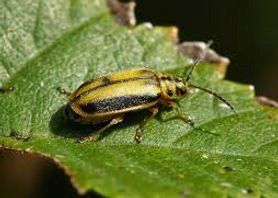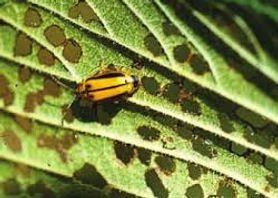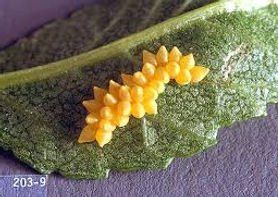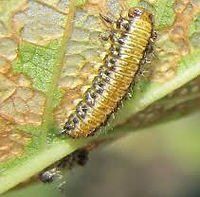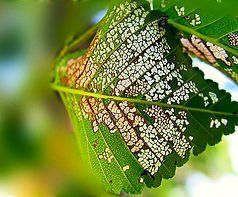Elm Leaf Beetle Management and Control in Cooma
Elm Leaf Beetle (Pyrrhalta luteola) is an introduced species originating from the northern Hemisphere.
It has been responsible for extensive damage to Elm tree populations throughout Europe, North Africa, and Eurasia It is now becoming a serious issue within Australia.
Untreated the beetle can defoliate a tree in weeks and presents a serious threat to elm tree populations in Australia.
Elm Leaf Beetle was first discovered in the Mornington Penninsula of Victoria in 1989, it is believed that it may have entered into the country up to 10 years before then. It was detected in Launceston in late 2002 and in Hobart in 2008. It is now well established in all these cities. There has been evidence of the outward spread of the beetle from these cites, with sightings of the beetle in Elms throughout the South East.
Elms have been a popular choice of ornamental trees throughout the South East region. There are considered to be 70,000 Elms in Victoria alone. With some 5,600 of these being registered as significant by the National Trust of Australia.
Due to the significant decrease in elm tree populations in the Northern Hemisphere caused by Elm Leaf Beetle and Dutch Elm Disease, Australia's southeast holds some of the most important populations of Elms in the world. Therefore, these trees' cultural and botanical significance is driving a considerable effort to control the beetle populations.
It is important to state that this threat is not Dutch Elm Disease. There is no evidence of Dutch Elm Disease in the country as yet. The Elm Leaf Beetle is an entirely different pest, but like Dutch Elm Disease, it can devastate elm tree populations.
The Elm Leaf Beetle predominately feeds on Elm trees, with the European varieties being most susceptible to significant infestations. However, Asian and American varieties of elm can show some degrees of susceptibility as well.
The most susceptible species are:
- English Elm (Ulmus procera).
- Dutch Elm (Ulmus x hollandica).
- Scotch Elm (Ulmus glabra)
- Golden Elm (Ulmus glabra 'Lutescens').
- Camperdown Elm (Ulmus glabra 'Camperdownii').
- Horizontal Elm (Ulmus glabra ' Pendula').
- Smooth-leaf Elm (Ulmus minor).
- Silver Elm (Ulmus minor 'Variegata').
It is thought that American Elm (Ulmus Americana) and Siberian Elm ( Ulmus pumila) may also be susceptible, although to a lesser extent. In comparison, Chinese Elm (Ulmus parvifolia) may well be resistant to infestation.
Life cycle:
The elm leaf beetle develops through four life stages: egg, larva, pupa, and adult. Adults commonly overwinter in bark crevices and woodpiles or in buildings. They fly to elm foliage and chew leaves in spring, and females lay eggs. Eggs hatch into larvae that develop through three instars (growth stages) over several weeks while chewing on foliage and then crawling down the tree trunk. Mature larvae become curled and inactive (a stage referred to as prepupae), then pupate around the tree base, sometimes in large numbers. After about ten days as pupae, adults emerge and fly to the canopy to feed and lay eggs during spring and summer.
Identification:
Larvae resemble caterpillars and are black when newly hatched shortly after moulting (shedding the old skin). After feeding, larvae become yellowish to green with rows of tiny dark tubercles (projections). Larvae grow up to 12mm long and have dense rows of dark tubercles down their sides that resemble two black stripes. The damage they cause is the skeletonisation of the leaf.
Control:
It is important to note that severe infestations of Elm Leaf Beetle will defoliate a tree quite rapidly, and if this happens continually, the tree may die. If the tree is exposed to the beetle for only one or two years or if the damage is not too significant, the tree may very well survive.
So controls must be implemented to ensure that severe infestations do not occur year after year.
Unfortunately, total eradication of the pest is unlikely in the short term. So the best option is to look at a long term approach using an Integrated Pest Management (IPM) system. Speaking with your local Arborist and formulating a system involving planning, monitoring, treatment, and evaluating the outcomes. Generally, it comes down to vigilant monitoring of your trees to assess and maintain their health. If the pest is badly defoliating your trees in the spring, it is not too late for an arborist to visit and effectively treat the tree. It is essential to monitor the trees for beetle and beetle larvae numbers.
Treatment and control options:
Professionally applied treatments. Important note: Only an Arborist who is licenced to apply chemicals/insecticides can use the following methods.
Trunk Injection:
Trunk injection with Imidacloprid is considered to be the most effective and environmentally safe option for the control of Elm Leaf Beetle. The insecticide is injected directly into the tree's trunk via small drill holes. The tree transports the chemical through the xylem to the leaves, where it acts as an effective neurotoxin, killing the beetles. It is necessary to use narrow diameter, slow delivery injectors, which are only used when the tree is naturally transporting water, i.e. when the tree is in leaf and photosynthesising.
It is important not to drill in winter as almost no natural transpiration occurring. So the transport of the chemical to the leaves is inefficient at this time. Also, the force needed to deliver the chemical into the tree increases the potential for tissue damage and decay within the tree.
Advantages:
- Fast-acting treatment protecting within days of administering the chemical.
- Protects for up to 3 years.
- Application is relatively fast.
- Very useful in the tree with no access to the roots. Under concrete paths, driveways, decks etc
Soil Injection:
A method used to reduce Elm Leaf Beetle damage is a soil-inject systemic insecticide. The soil beneath the elm tree is injected with insecticide. The tree then absorbs the chemical into its vascular system and is transported to the leaves, where it has its effect on the beetle adults and larvae.
This technique is applied in late winter and early spring because the systemic insecticide will be more readily transported throughout the tree at this time. The surrounding soil profile must be moist to ensure adequate uptake by the tree of the chemical, which may not be beneficial or may reduce the chemical efficancy during drought conditions.
This method can kill organisms in the soil, such as earthworms. Applications near rivers and creeks or any food garden pose a risk to invertebrates and human health.
Foliage spray:
An insecticide is sprayed onto the foliage using a pressurised spray unit which is designed to reach as much of the canopy as possible.
Advantages:
- Fast-acting results stops Elm leaf damage immediately.
- A good level of protection can be achieved if the application occurs at the optimal time. It may well last an entire season, but it is unlikely. A follow-up spray may be required.
- Cheaper intial outlay than some of the longer term treatment options.
Disadvantages
- Over-spray. Because the chemical is an insecticide, it may cause the mortality of many other insects within the vicinity.
- It needs to be applied yearly if all leaf damage is to be avoided.
- After multiple applications, i.e. year after year may become a more expensive treatment option.
- Will not reach the top of tall trees, about 10m-12m and above.
Organic Controls:
There is a range of controls that do not include inorganic or synthetic chemicals. These organic control methods are generally less effective than the above-mentioned artificial chemical controls. However, they can reduce the presence and prevalence of the beetle in some situations.
- Removal of the beetle by hand. This method is only efficient on small trees.
- Addressing other tree health issues. A healthy tree is more likely to survive an infestation than an unhealthy tree.
- Selection of Elm leaf Beetle resistant species, Chinese Elm.
- Trunk Banding and Trunk Wrapping. These methods involve breaking the Elm Leaf Beetle life cycle as the pupae descend the tree to pupate.
Biological Controls:
Presently some parasitic and natural enemies of the Elm Leaf Beetle are studied, tested and evaluated. These include a wasp, Oomyzusgallerucae and a small fly, Erynniopsisantennata.
There is also in development a spray containing a naturally occurring bacterium Bacillus thuringiensis subsp. Tenebrionis. This spray is effective against the Elm Leaf Beetle larvae.
Cultural Practices:
Maintaining good tree health is very important for tree resilience to environmental pressures, including the impact of Elm Leaf Beetle infestations.
These include:
- Maintaining adequate soil moisture.
- Avoiding direct and indirect damage to tree roots through soil compaction or root severance.
- Avoid wounding trees through poor pruning/loping practices.
- Encouraging the development and maintenance of the soil profile by introducing organic matter, i.e. mulch, leaf litter etc.

